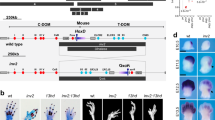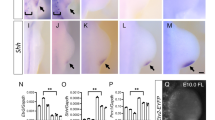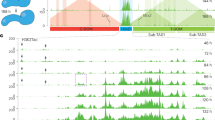Abstract
IN the limb bud the 5' members of the Hox-4 gene cluster are expressed in a nested set of overlapping domains which are progressively restricted in the posterior and distal directions1. These domains arise early in limb bud development and come to approximate the primordia of the major structural elements of the limb along the anterior/posterior axis2 (Fig. 1). This pattern, and the fact that surgical manipulations which lead to mirror image duplications along the anterior/posterior axis give rise to mirror image duplications of the domains of expression of these genes, have led to the proposal that these transcription factors specify positional identity along the anterior/posterior axis3,4. Here we test this hypothesis directly using replication-competent retroviral vectors to expand the domain of expression of the Hox-4.6 gene anteriorly during limb development in vivo.We report that alteration of the domain of expression of the Hox-4.6 gene in the developing limb leads to reproducible pattern alterations consistent with a posterior homeotic transformation.
This is a preview of subscription content, access via your institution
Access options
Subscribe to this journal
Receive 51 print issues and online access
$199.00 per year
only $3.90 per issue
Buy this article
- Purchase on Springer Link
- Instant access to full article PDF
Prices may be subject to local taxes which are calculated during checkout
Similar content being viewed by others
References
Dolle, P., Izpisu̇a-Belmonte, J. C., Falkenstein, H., Renucci, A. & Duboule, D. Nature 342, 767–772 (1989).
Yokouchi, Y., Sasaki, H. & Kuroiwa, A. Nature 353, 443–445 (1991).
Nohno, T. et al. Cell 64, 1197–1205 (1991).
Izpisúa-Belmonte, J. C., Tickle, C., Dolle, D., Wolpert, L. & Duboule, D. Nature 350, 585–589 (1991).
Hughes, S., Greenhouse, J., Petropoulos, C. & Sutrave, P. J. Virol. 61, 3004–3012 (1987).
Izpisúa-Belmonte, J. C., Falkenstein, H., Dolle, P., Renucci, A. & Duboule, D. EMBO J. 10, 2279–2289 (1991).
Rogina, B., Coelho, C. N., Kosher, R. A. & Upholt, W. B. Devl Dynamics 193, 92–101 (1992).
Hamburger, V. & Hamilton, H. L. J. exp. Morphol. 88, 49–92 (1959).
Summerbell, D. J. Embryol. exp. Morphol. 32, 227–237 (1974).
Macleod, M. J. Teratol 22, 299–301 (1980).
Bowen, J., Hinchliffe, J., Horder, T. J., & Reeve, A. M. F. Anat. Embryol. 179, 269–283 (1989).
Cepko, C. Neuromethods 16, 177–219 (1989).
Dolberg, D. & Bissel, M. Nature 309, 552–558 (1984).
Potts, W., Olsen, M., Boettiger, D. & Vogt, V. J. gen. Virol. 68, 3177–3182 (1987).
Hurle, J. M., Ganan, Y. Anat. Embryol. 176, 393–399 (1987).
Author information
Authors and Affiliations
Rights and permissions
About this article
Cite this article
Morgan, B., Izpisúa-Belmonte, JC., Duboule, D. et al. Targeted misexpression of Hox-4.6 in the avian limb bud causes apparent homeotic transformations. Nature 358, 236–239 (1992). https://doi.org/10.1038/358236a0
Received:
Accepted:
Published:
Issue Date:
DOI: https://doi.org/10.1038/358236a0
This article is cited by
-
Foamy virus for efficient gene transfer in regeneration studies
BMC Developmental Biology (2013)
-
Copy number analysis of 413 isolated talipes equinovarus patients suggests role for transcriptional regulators of early limb development
European Journal of Human Genetics (2013)
-
Making digit patterns in the vertebrate limb
Nature Reviews Molecular Cell Biology (2006)
-
The chicken as a model for large-scale analysis of vertebrate gene function
Nature Reviews Genetics (2003)
-
Approaches to a comparison of fin and limb structure and development
Theory in Biosciences (2003)
Comments
By submitting a comment you agree to abide by our Terms and Community Guidelines. If you find something abusive or that does not comply with our terms or guidelines please flag it as inappropriate.



